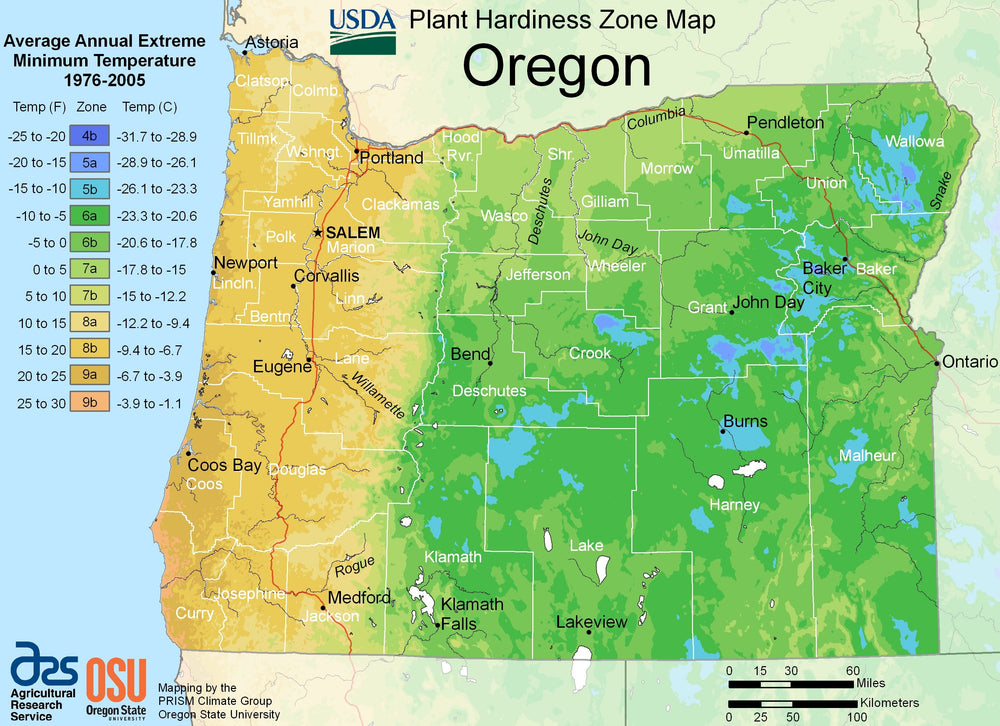Image from USDA
Characteristics of Oregon Planting Region
The climate in Oregon is typically mild with cool summers and cold winters and varies across the region.
-
The Coastal Area
This region experiences mild to cool temperatures throughout the year, with plenty of wind and fog. Despite the longer growing season of 190 - 250 days, gardeners will struggle with the weather and lower temperatures in this area.
-
Western Valleys
Winters are very mild, and summers are characterized by warm days and cool nights in this part of the state. The growing season is anywhere between 150 and 250 days; however, the dates can change every year.
-
Central and Eastern Regions
The Cascade mountain range and the high-elevation desert area experience short growing seasons of between 90 and 120 days. It’s important to note that frost can realistically happen on any day of the year in this region.
-
Columbia and Snake River Valleys
Hot days and warm nights are frequent in this area. The planting season will last anywhere between 120 and 200 days; however, gardeners may face difficulties with heat and wind drying out their crops.
Additionally, Oregonians across the state may experience temperature extremes, earthquakes, wildfires, winter storms, and flooding throughout the year.

View of Mount Hood, Oregon, USA
Challenges of Growing in Oregon
1. Severe Weather
The extreme weather conditions across the region present a variety of difficulties for gardeners. Raised garden beds and protective coverings are recommended to keep your hard work safe from the floods and winter storms in the area.
2. Temperature Extremes
Despite the generally mild climate across the region, Oregon will experience extreme temperature fluctuations throughout the year. Severe heatwaves in the summer months are expected, so it’s suggested to utilize indoor and ventilated growing to keep your plants alive and well.
3. High Elevation
Much of the state sits at a higher altitude, presenting a range of difficulties for gardeners in these areas. Temperamental weather, poor soil conditions, low humidity, and the danger of frosts throughout the year are a few obstacles gardeners are faced with here.

View of Three Sisters Mountains, Oregon, USA
The Benefits of Using a Greenhouse in Oregon
A Planta greenhouse can offer Oregonians an extended growing season, protection from extreme weather and early frosts, and a cool, ventilated area for pants to thrive even during a heatwave. Additionally, gardeners will have the ability to grow a much wider variety of plants than traditional outdoor growers.
1. Extend your Growing Season
-
Without a Greenhouse:
The growing season varies dramatically across the region and can sit anywhere between 90 and 250 days, depending on where you’re located. However, it’s important to note that various difficult weather conditions may create a challenging environment for gardeners despite the extended planting season in some parts of the state.
-
With a Greenhouse:
A Planta Greenhouse will allow gardeners to double or triple their growing seasons in Oregon. In higher altitude areas, the planting season can easily be extended between 7-9 months, while those living on the coast and in the valleys can potentially grow all year round.
Learn more about specific growing dates for your area and the best vegetables to plant in each part of Oregon.


Customer images of the Sungrow Greenhouse in a similar climate
Grow a Wider Variety of Vegetables
-
Without a Greenhouse:
While vegetable options will vary for gardeners depending on what planting zone and part of the state you’re located in, cold-hardy vegetables are suggested for the cooler climate and the potential for snap frosts. Some of the recommended vegetables for this region include:
- Broccoli
- Beets
- Arugula
- Kale
- Chard
- Spinach
- Lettuce
- Cabbage
-
With a Greenhouse:
Greenhouse gardening will allow Oregonians to confidently plant a broader range of vegetables, including long-season and warm-season crops. Some of the vegetables known to thrive in a greenhouse in this region include:
- Artichoke
- Asparagus
- Beans
- Cauliflower
- Carrots
- Corn
- Cucumbers
- Eggplant
- Garlic
- Onions
- Sweet Peppers
- Potatoes
- Pumpkins
- Winter Squash
- Tomatoes
- Summer Squash
- Melons
- Cherry Tomatoes
- Hot Peppers
- Scallions
- Cilantro
- Dill
- Celery
- Watermelon
- Okra

Vegetable Garden
Why Planta Greenhouses?
- Wind resistant up to 65 mph (learn more about how our greenhouses hold up in high-altitude climates).
- Withstands a snow load of up to 98 psf (480kg/square meter).
- Made with a heavy-duty galvanized steel frame.
- Polycarbonate panels provide 100% protection against UV rays.
- The Sungrow greenhouse is bell-shaped - allows the wind, snow, and hail to slide off the sides.
- Extendable (Sungrow, Sigma and Farmer models can be extended beyond 100ft)
- Made in Europe and are exclusively imported
- Maintenance-free

